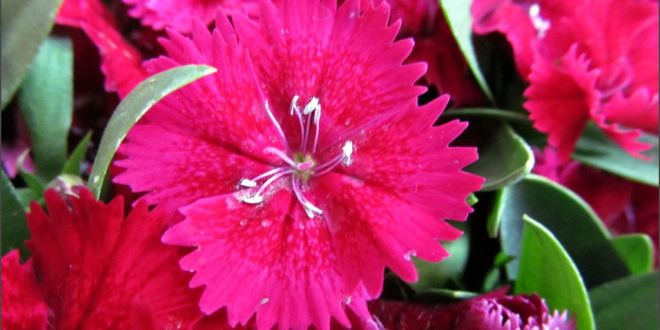The name Dianthus is from the Greek words dios (“god”) and anthos (“flower”), and was cited by the Greek botanist Theophrastus. The color pink may be named after the flower, coming from the frilled edge of the flowers: the verb “pink” dates from the 14th century and means “to decorate with a perforated or punched pattern”.
Ecology: Dianthus species are used as food plants by the larvae of some Lepidoptera species including Cabbage Moth, Double-striped Pug, Large Yellow Underwing and The Lychnis
Dianthus species have been extensively bred and hybridised to produce many thousands of cultivars for garden use and floristry, in all shades of white, pink, yellow and red, with a huge variety of flower shapes and markings. They are often divided into the following main groups:
- Border carnations – fully hardy, growing to 60 cm (24 in), large blooms
- Perpetual flowering carnations – grown under glass, flowering throughout the year, often used for exhibition purposes, growing to 150 cm (59 in)
- Malmaison carnations – derived from the variety ‘Souvenir de la Malmaison’, growing to 70 cm (28 in), grown for their intense “clove” fragrance
- Old-fashioned pinks – older varieties; evergreen perennials forming mounds of blue-green foliage with masses of flowers in summer, growing to 45 cm (18 in)
- Modern pinks – newer varieties, growing to 45 cm (18 in), often blooming two or three times per year
- Alpine pinks – mat-forming perennials, suitable for the rockery or alpine garden, growing to 10 cm (4 in)
Details
Family: Caryophyllaceae (kar-ree-oh-fil-AY-see-ee) (Info)
Genus: Dianthus (dy-AN-thus) (Info)
Species: deltoides (del-TOY-deez) (Info)
Category:
Perennials
Height:
under 6 in. (15 cm)
Spacing:
9-12 in. (22-30 cm)
Hardiness:
USDA Zone 3a: to -39.9 °C (-40 °F)
USDA Zone 3b: to -37.2 °C (-35 °F)
USDA Zone 4a: to -34.4 °C (-30 °F)
USDA Zone 4b: to -31.6 °C (-25 °F)
USDA Zone 5a: to -28.8 °C (-20 °F)
USDA Zone 5b: to -26.1 °C (-15 °F)
USDA Zone 6a: to -23.3 °C (-10 °F)
USDA Zone 6b: to -20.5 °C (-5 °F)
USDA Zone 7a: to -17.7 °C (0 °F)
USDA Zone 7b: to -14.9 °C (5 °F)
USDA Zone 8a: to -12.2 °C (10 °F)
USDA Zone 8b: to -9.4 °C (15 °F)
USDA Zone 9a: to -6.6 °C (20 °F)
USDA Zone 9b: to -3.8 °C (25 °F)
Sun Exposure:
Full Sun
Sun to Partial Shade
Danger:
Parts of plant are poisonous if ingested
Bloom Color:
Pink
Red
White/Near White
Bloom Time:
Mid Summer
Foliage:
Evergreen
Other details:
Average Water Needs; Water regularly; do not overwater
This plant is attractive to bees, butterflies and/or birds
Soil pH requirements:
6.6 to 7.5 (neutral)
7.6 to 7.8 (mildly alkaline)
7.9 to 8.5 (alkaline)
8.6 to 9.0 (strongly alkaline)
Patent Information:
Non-patented
Propagation Methods:
By dividing the rootball
From seed; direct sow outdoors in fall
From seed; winter sow in vented containers, coldframe or unheated greenhouse
From seed; sow indoors before last frost
From seed; direct sow after last frost
Seed Collecting:
Allow pods to dry on plant; break open to collect seeds
Allow seedheads to dry on plants; remove and collect seeds
Read more: http://davesgarden.com/guides/pf/go/4/#ixzz3GpN4C6Sn








